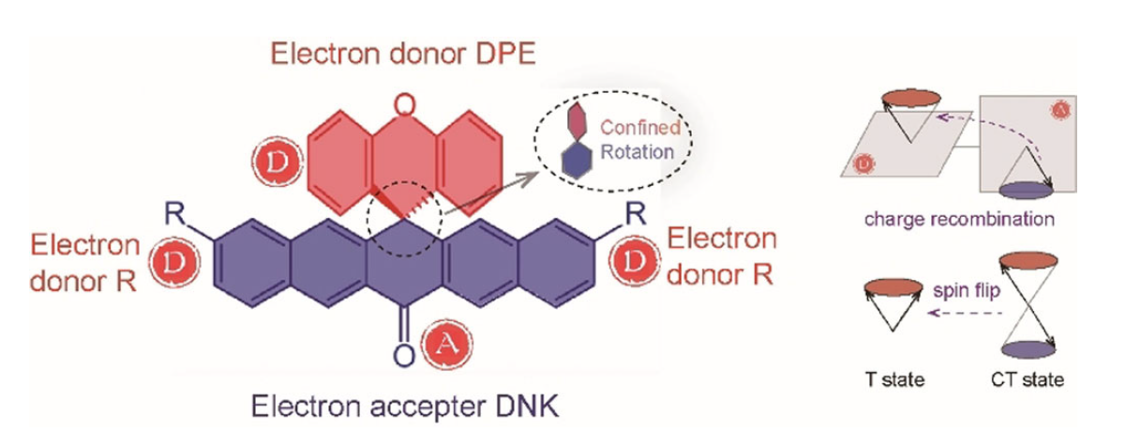Heavy-atom-free triplet sensitizers with predictable properties
An atomic state in which two spin angular momenta of electrons cancel each other, resulting in zero net spin, is called a singlet. If the angular momenta combine to give a total non-zero spin, then that state is called a triplet. A triplet state usually has lower, sometimes substantially lower, energy than a singlet. Importantly, the triplet excited state is the cornerstone of applications such as photodynamic therapy, photo-catalysis for organic synthesis, solar energy harvest, photo-upconversion, or oxygen sensing, among others. Triplet generators are, thus, most interesting species.
![]()

There is a process, called intersystem crossing, in which a singlet excited electronic state makes a transition to a triplet excited state at the point where the potential energy curves for the excited singlet and triplet states cross. Importantly, this transition is forbidden in the absence of spin-orbit coupling but occurs in the presence of spin-orbit-coupling. This is why several structural features often lead to triplet state generation in organic chromophores. For example, the incorporation of heavy-atoms facilities intersystem crossing through an enhanced spin–orbit coupling. A triplet formed via intersystem crossing is frequently in an excited vibrational state.
Interestingly, charge recombination due to a charge transfer also results in an efficient triplet state generation, in which the orbital angular momentum change induced by the charge recombination is compensated by a spin flip for total angular momentum conservation. This mechanism, referred to as spin–orbit charge transfer intersystem crossing (SOCT-ISC), has led to the discovery of a range of triplet sensitizers.
But it is not that easy. The excited vibrational triplet state can reach its lowest vibrational state by collisions with other molecules. The transition from this state to the singlet state is forbidden in the absence of spin-orbit coupling but allowed when there is spin-orbit coupling. This gives rise to the slow emission of electromagnetic radiation known as fluorescence. Given that fluorescence emission, vibrational relaxation or charge recombination directly to the ground state, usually co-exist with intersystem crossing, it is rather difficult to manipulate these processes through chemical modification.
Multiple factors enhancing intersystem crossing interfere with each other and, in order to maximize triplet yield, other competitive excited state relaxation channels have to be suppressed. So, it comes as no surprise that these exceptional collection of features in a molecule is rarely reported.

A spiro compound is a molecule in which there are two rings linked through a single atom (the spiro atom). A team of researchers had shown that the use of a spiro-linkage can lock the electron donor and acceptor in an orthogonal geometry with close proximity Now, that same team reports 1 the synthesis and photophysical properties of a family of spiro-conjugated triplet generators in solution.
Intersystem crossing is enhanced so much in spirobis[anthracene]-diones, that a record-high SOCT-ISC rate constant is achieved. This rate constant is inherited by the new spiro-conjugated triplet generators due to their asymmetry. Triplet generation efficiency could be further enhanced by stabilizing the spiro-charge-transfer state. The new spiro-compounds consist of electron-rich diphenyl ether as the donor and electron-deficient dinaphthyl ketone as the acceptor. Through side group engineering, near-unity triplet generation is achieved with further assistance from spin-vibronic coupling.
The application of the new compounds as triplet sensitizers and in medicine was tested by triplet-triplet energy transfer and photodynamic therapy experiments.
These results show that multiple important factors can be combined to enhance triplet state generation without interference via a rigid asymmetric spiro-conjugated molecular motif, providing a pathway to the design of heavy-atom-free triplet sensitizers with predictable properties.
Author: César Tomé López is a science writer and the editor of Mapping Ignorance
Disclaimer: Parts of this article may have been copied verbatim or almost verbatim from the referenced research paper/s.
References
- Meng Lv, Xicun Lu, Yanrong Jiang, María E. Sandoval-Salinas, David Casanova, Haitao Sun, Zhenrong Sun, Jianhua Xu, Youjun Yang, and Jinquan Chen (2021) Near-Unity Triplet Generation Promoted via Spiro-Conjugation Angew. Chem. Int. Ed. doi: 10.1002/anie.202113190 ↩